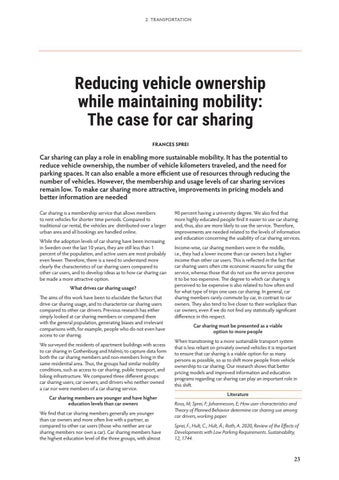2. TRANSPORTATION
Reducing vehicle ownership while maintaining mobility: The case for car sharing FRANCES SPREI
Car sharing can play a role in enabling more sustainable mobility. It has the potential to reduce vehicle ownership, the number of vehicle kilometers traveled, and the need for parking spaces. It can also enable a more efficient use of resources through reducing the number of vehicles. However, the membership and usage levels of car sharing services remain low. To make car sharing more attractive, improvements in pricing models and better information are needed Car sharing is a membership service that allows members to rent vehicles for shorter time periods. Compared to traditional car rental, the vehicles are distributed over a larger urban area and all bookings are handled online. While the adoption levels of car sharing have been increasing in Sweden over the last 10 years, they are still less than 1 percent of the population, and active users are most probably even fewer. Therefore, there is a need to understand more clearly the characteristics of car sharing users compared to other car users, and to develop ideas as to how car sharing can be made a more attractive option. What drives car sharing usage? The aims of this work have been to elucidate the factors that drive car sharing usage, and to characterize car sharing users compared to other car drivers. Previous research has either simply looked at car sharing members or compared them with the general population, generating biases and irrelevant comparisons with, for example, people who do not even have access to car sharing. We surveyed the residents of apartment buildings with access to car sharing in Gothenburg and Malmö, to capture data form both the car sharing members and non-members living in the same residential area. Thus, the groups had similar mobility conditions, such as access to car sharing, public transport, and biking infrastructure. We compared three different groups: car sharing users; car owners; and drivers who neither owned a car nor were members of a car sharing service. Car sharing members are younger and have higher education levels than car owners We find that car sharing members generally are younger than car owners and more often live with a partner, as compared to other car users (those who neither are car sharing members nor own a car). Car sharing members have the highest education level of the three groups, with almost
90 percent having a university degree. We also find that more highly educated people find it easier to use car sharing and, thus, also are more likely to use the service. Therefore, improvements are needed related to the levels of information and education concerning the usability of car sharing services. Income-wise, car sharing members were in the middle, i.e., they had a lower income than car owners but a higher income than other car users. This is reflected in the fact that car sharing users often cite economic reasons for using the service, whereas those that do not use the service perceive it to be too expensive. The degree to which car sharing is perceived to be expensive is also related to how often and for what type of trips one uses car sharing. In general, car sharing members rarely commute by car, in contrast to car owners. They also tend to live closer to their workplace than car owners, even if we do not find any statistically significant difference in this respect. Car sharing must be presented as a viable option to more people When transitioning to a more sustainable transport system that is less reliant on privately owned vehicles it is important to ensure that car sharing is a viable option for as many persons as possible, so as to shift more people from vehicle ownership to car sharing. Our research shows that better pricing models and improved information and education programs regarding car sharing can play an important role in this shift. Literature Roos, M; Sprei, F; Johannesson, E; How user characteristics and Theory of Planned Behavior determine car sharing use among car drivers, working paper. Sprei, F.; Hult, C.; Hult, Å.; Roth, A. 2020, Review of the Effects of Developments with Low Parking Requirements. Sustainability, 12, 1744.
23
























